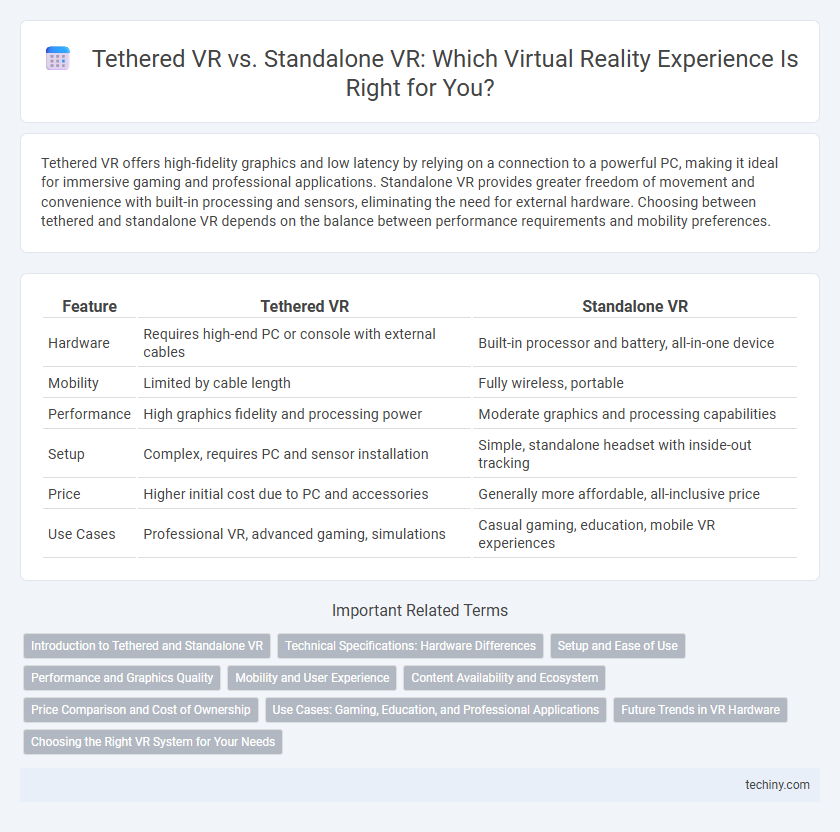Tethered VR offers high-fidelity graphics and low latency by relying on a connection to a powerful PC, making it ideal for immersive gaming and professional applications. Standalone VR provides greater freedom of movement and convenience with built-in processing and sensors, eliminating the need for external hardware. Choosing between tethered and standalone VR depends on the balance between performance requirements and mobility preferences.
Table of Comparison
| Feature | Tethered VR | Standalone VR |
|---|---|---|
| Hardware | Requires high-end PC or console with external cables | Built-in processor and battery, all-in-one device |
| Mobility | Limited by cable length | Fully wireless, portable |
| Performance | High graphics fidelity and processing power | Moderate graphics and processing capabilities |
| Setup | Complex, requires PC and sensor installation | Simple, standalone headset with inside-out tracking |
| Price | Higher initial cost due to PC and accessories | Generally more affordable, all-inclusive price |
| Use Cases | Professional VR, advanced gaming, simulations | Casual gaming, education, mobile VR experiences |
Introduction to Tethered and Standalone VR
Tethered VR systems rely on wired connections to a powerful PC or console, enabling high-fidelity graphics and complex interactions through external processing units. Standalone VR devices operate independently with built-in processors, batteries, and storage, offering greater mobility and ease of use without external hardware. The choice between tethered and standalone VR depends on user needs, balancing performance capabilities and freedom of movement.
Technical Specifications: Hardware Differences
Tethered VR systems rely on external hardware such as high-performance PCs or gaming consoles, offering superior processing power, graphics quality, and lower latency through wired connections, often using USB-C or HDMI cables. Standalone VR headsets incorporate built-in processors, batteries, and storage, enabling wireless freedom but with limitations in graphical fidelity, battery life, and processing capacity due to hardware constraints. Display resolution, refresh rate, sensor accuracy, and tracking methods also differ, with tethered VR typically supporting higher resolutions and advanced inside-out or external tracking systems compared to the more compact, integrated sensors found in standalone devices.
Setup and Ease of Use
Tethered VR systems require a physical connection to a powerful PC or console, demanding more complex setup with cables and external sensors, which can limit mobility and increase preparation time. Standalone VR headsets offer a plug-and-play experience with built-in processors and tracking, enabling quick and wireless setup ideal for casual users and portable use. Ease of use in standalone VR is enhanced by streamlined interfaces and fewer hardware dependencies, making it accessible for beginners without technical expertise.
Performance and Graphics Quality
Tethered VR systems deliver superior performance and graphics quality by leveraging the processing power of a connected PC or console, resulting in higher resolution visuals and smoother frame rates. Standalone VR headsets rely on integrated hardware, which limits graphical fidelity and computational capacity but allows for greater mobility and ease of use. High-end tethered devices like the Oculus Rift S or HTC Vive Pro consistently outperform standalone options such as the Oculus Quest in rendering complex environments and maintaining low latency.
Mobility and User Experience
Tethered VR systems, tethered to powerful PCs or consoles, offer high-fidelity graphics and low latency but limit user mobility due to cables restricting movement. Standalone VR headsets provide greater freedom of motion and ease of use with built-in processors and wireless design, enhancing user comfort and immersion in a wider range of environments. The choice impacts user experience significantly, balancing graphical quality against unrestricted, intuitive interaction.
Content Availability and Ecosystem
Tethered VR systems benefit from extensive content libraries supported by powerful hardware and established platforms like Oculus Rift and HTC Vive, offering access to high-quality, graphically intensive experiences. Standalone VR devices such as Oculus Quest provide a growing ecosystem with increasingly diverse applications, emphasizing ease of use and wireless freedom, though their content selection remains more limited compared to tethered counterparts. Developers prioritize tethered VR for complex projects due to superior processing capabilities, while standalone VR is rapidly expanding its content ecosystem through cloud updates and cross-platform compatibility.
Price Comparison and Cost of Ownership
Tethered VR systems generally require a high-performance PC or console, increasing the initial investment to around $800-$1500 for hardware plus $400-$800 for the headset, leading to a higher total cost of ownership. Standalone VR headsets like the Meta Quest 3 offer a more affordable all-in-one solution priced between $300-$500, eliminating the need for external devices and reducing ongoing costs. While tethered VR provides superior graphics and processing power, standalone VR's lower price point and convenience make it more accessible for casual users and those seeking budget-friendly options.
Use Cases: Gaming, Education, and Professional Applications
Tethered VR offers high-performance experiences ideal for immersive gaming, advanced education simulations, and professional applications requiring powerful graphics and processing capabilities. Standalone VR provides greater mobility and ease of use, making it suitable for casual gaming, interactive learning environments, and remote professional training. Both platforms enable diverse use cases but differ in hardware dependency, with tethered VR relying on external PCs and standalone devices integrating all necessary components.
Future Trends in VR Hardware
Tethered VR systems continue advancing with higher-resolution displays and more powerful GPUs, enabling ultra-realistic experiences for professional and gaming markets. Standalone VR devices are evolving with improved processors and 5G connectivity, supporting greater mobility and seamless cloud-based content streaming. Emerging trends indicate a convergence of these technologies, leveraging edge computing and AI to deliver immersive VR experiences with reduced latency and enhanced user interaction.
Choosing the Right VR System for Your Needs
Tethered VR systems offer high-fidelity graphics and processing power by connecting to external PCs, making them ideal for immersive gaming and professional simulations. Standalone VR headsets provide greater mobility and ease of use with built-in hardware, perfect for casual users and quick setup scenarios. Assessing your priority between performance and convenience helps determine the best VR system tailored to your specific virtual reality experience requirements.
Tethered VR vs Standalone VR Infographic

 techiny.com
techiny.com